Sustainability, climate adaption and mitigation have become integral to urban policy and planning, but the social implications, for example the social justice and inequality issues of urban greening, have largely been overlooked. The concept of green gentrification focuses on these inequity implications of green urban development.
The guest in this podcast episode is Roberta Cucca, who is Associate Professor at the Norwegian University of Life Sciences (NMBU) in the Department of Urban and Regional planning, where she teaches Urban Sociology. Her main research interests are social– spatial inequalities in contemporary cities, the social dimensions of sustainability, and the multilevel governance of urban policies within a comparative urban studies perspective.
What is green gentrification?
– My interest in green gentrification started more than twelve years ago while I was a visiting researcher in Vancouver, which is a very green and attractive city, says Cucca.
Vancouver was recognised as a very good practice for sustainable planning, but the city was already affected by problems related to housing affordability and gentrification.
– Green gentrification occurs when the implementation of an environmental planning agenda related to public green, leads to the displacement or exclusion of the most economically vulnerable population, Cucca explains.
The focus of the first studies on green gentrification used to be mainly on the design and redevelopment of parks. One example is The High Line park in Manhattan, New York, which is often defined as the monument of green gentrification. However, the concept has slowly become familiar to urban scholars involved in gentrification studies, and nowadays there is a huge proliferation of studies on different aspects of environmental gentrification.
– The term blue gentrification can be used to describe the implications of housing affordability at redeveloped waterfronts, says Cucca.
Another term is low-carbon gentrification, which is related to the increasing housing cost in connection to ecological retrofitting for energy efficiency goals.
– We can also talk about climate gentrification, for example by looking at increasing housing costs in neighbourhoods not affected by rising sea levels in cities exposed to this risk, like Miami, Cucca continues.
The Isola neighbourhood in the centre of Milan is an interesting case of so-called green branding. Isola became a tourist attraction after the construction of the Bosco Verticale (“vertical forest”) skyscraper.
– In general, the focus of green gentrification studies is on cases where gentrification is kicked off by a green intervention.
Some green interventions are included in redevelopment programs led by real-estate interests and private actors. There are also examples of state-led green gentrification, such as area-based programs targeting specific blue or green infrastructure.
– Unfortunately, there is also the paradoxical case of green gentrification being kicked off by civil society organizations, especially activists on the topic of environmental justice. There are a few examples of this in North America, Cucca explains.
Greening can also be a result of gentrification, as highly educated professionals are often quite interested in having a sustainable urban lifestyle. However, Cucca emphasizes how their studies are generally more interested in the cases where green gentrification is caused by green and blue interventions.

Contextual differences and strategies
– More research is needed to understand and identify the contextual factors that affect green gentrification.
– Green gentrification is not a destiny. Sustainability do not always generate this process and it is important to disentangle when, where and why green gentrification happens, Cucca elaborates.
Some cities have quite strong housing policies in place, which may help limit or postpone the process of green gentrification. Additionally, the availability of green and environmental amenities, and the even distribution of these amenities in an urban area, make these areas less at risk of green gentrification. Central areas may be more affected by green gentrification. At the same time, the typology of the intervention, and contextual differences play a huge role in how the process unfolds.
– In terms of policy implications, the most important strategy is consistent with implementing tools that may be applied to contrast and limit gentrification in general.
– An interesting example is the strategy of soft urban renewal, implemented in Vienna, where they apply rent control mechanisms and produce new social housing, while upgrading green infrastructures in vulnerable districts, Cucca continues.
Monitoring of the effects of these strategies has shown that they have been quite effective in postponing or limiting green gentrification. The “Just Green Enough” approach in planning, elaborated by activists in North America, is another strategy to limit negative social implications of urban greening.
– Here the focus is more on shifting the design implementation from what we define as spectacular green interventions, towards more ordinary and less spectacular interventions, scattered through the city and designed with the support of the local population.
Cucca stresses that another important aspect of policy implementation is related to increasing awareness about the risk of green gentrification. This is crucial for providing some tools to take into consideration the risk of gentrification, while providing new green or blue infrastructures.
– We must not forget that climate adaptation and greening are absolutely necessary and urgent, and especially the most vulnerable are in need of this kind of infrastructures, because we know that climate injustice is a huge issue in contemporary cities, Cucca explains.
Vulnerable groups, such as the elderly, people with disabilities and children, are particularly affected by the implications of climate change, for example when it comes to heat waves and other extreme weather events.
There may be a gap or disconnection between how planners and politicians see the need for green interventions in city districts, and the needs of the people living in these districts who are affected by these interventions.
– In Germany there are several committees fighting against ecological retrofitting of social housing units, to avoid increasing rental costs.
Green gentrification in Oslo
Oslo has high ambitions when it comes to climate mitigation and adaption, which is recognised internationally. There are several examples of spectacular interventions in the city centre, such as the waterfront redevelopment along the fjord and the preservation of Marka, thanks to strategies of densification. At the same time, housing policies are extremely weak in Oslo and gentrification– like processes are quite evident in large parts of the inner eastern district of the city.
– The renovation of the park alongside Akerselva has played a huge role in gentrification going on in areas such as Grunerløkka, Sagene and Nydalen, says Cucca.
– The awareness of the risk of green gentrification is quite low, especially among public authorities in Oslo, Cucca continues.
The debate surrounding gentrification, and how to contain it is quite weak in Norway compared to other countries.
– I think academics should play a huge role in rising awareness about the risk of gentrification, and green gentrification in particular, says Cucca.
Listen to Associate Professor Roberta Cucca in conversation with Professor Per Gunnar Røe on green gentrification.
